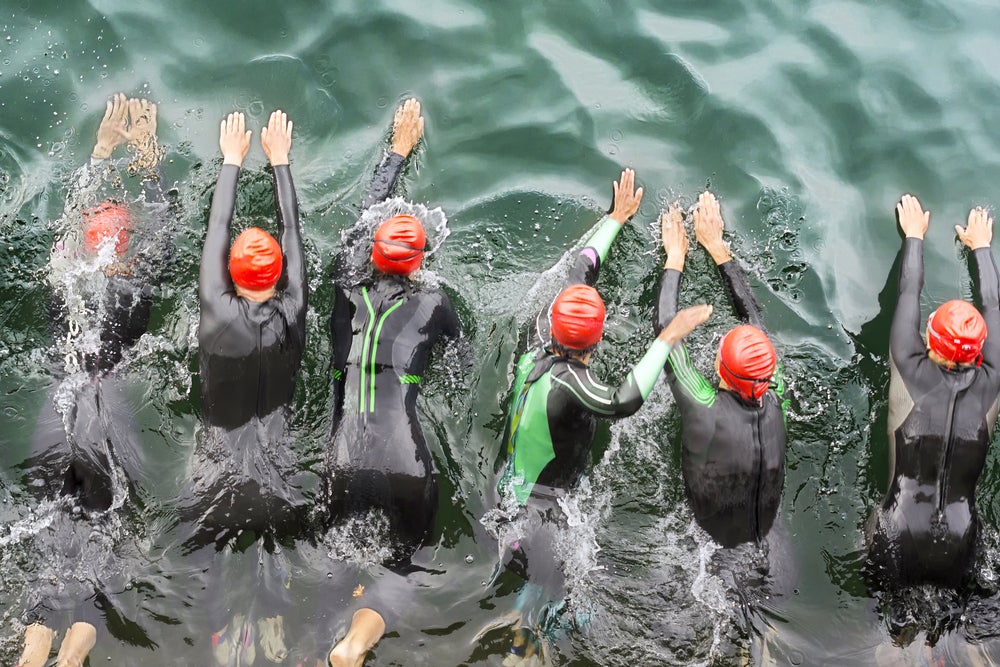Beginner's Luck: Open-Water Tips and Tricks (Part I)

Photo: Shutterstock.com
“Beginner’s Luck” columnist Meredith Atwood shares advice on becoming a confident open-water swimmer.
This is how my very first open-water swim went: I have confidence (I got this! I am a good swimmer!), put on the wetsuit (ah, this is interesting and tight), and into the freezing water (I am absolutely going to DIE!).
(You can read my first experience here.)
But I kept at it, swim after swim and race after race. I even managed an Ironman swim at Ironman Lake Placid in 1:13—not too shabby—which is just proof that getting over the fear can be done.
Have heart! The worst part about open water: the first handful of times you experience it. Of course, the fears and terrors may continue to plague you, unless you decide to tackle them. So here we go.
The best part about open water: the fear is surmountable!
Step One: You must know how to swim (and swim often).
Just like you must run and cycle to get better, you must get in the pool and (unfortunately, sometimes), also the river, lake, ocean or bay. Practice may not make perfect, but practices does make proficient and calm.
Knowing how to swim may seem like a no-brainer, but I am always a tad surprised by the number of folks who go to a race not really knowing how to swim. So let’s start there: swim lessons, videos, master’s swim or practice with a buddy. Be comfortable swimming in the pool before you attempt to get in the lake, ocean, bay, pond, river or septic tank near you. You should be able to swim a decent distance, continuously, before attempting open water. I would say at least 400-500 meters (16-20 lengths in a pool).
Why? Well, because in the open water, there are no walls, or sides, or resting places. So you need to feel confident that you can swim a short distance without needing to stop.
Next, it helps to learn to bilateral breathe in the pool (breathing on both sides)—even if not for every workout, but the ability to breathe on either side may prove helpful on race day if you find yourself breathing on the side with the sun or the waves, you might want to switch it up.
I encourage every beginner, on their first open-water swim (OWS), to swim parallel to the shore, at a depth where he or she can stand up and rest, if needed. Don’t just swim straight out to the big cruise ship anchored a mile away. Take your time, find a spot about chest-deep, and swim along the shoreline.
If you feel nervous, just stand up.
Compose yourself, catch your breath, say “I can do this,” and get back to it.
If you know that you can swim 400-500 meters continuously and you swim parallel to the shore for your first time, you will have a much better experience.
PSA: Do not get in the open water for the first time in your first race. That is insane! You are potentially setting yourself up for failure, for danger and for a terrible experience. Just practice 4-5 times before your first race, and everyone will do much better.
Also, do not swim alone. Have a swim buddy go with you, preferably someone who has experience in the open water. If not, then both of you definitely stay where you can touch the bottom.
Having a few open-water experiences pre-race teaches you a few things:
– What are your open-water weaknesses?
– How strong mentally do you really need to be? In other words, are you reasonably comfortable in the water and you can say, “Go get ’em tiger” and be okay? Or are you going to need some serious affirmations, daily-Stuart Smalley style, to make race day happen?
– How does your wetsuit feel? (if applicable) Do you have enough lube in the right places? (discussed below) How do your goggles fit?, etc.
It’s all about the practice, baby!
Step Two: Talk Truth
I attended the USAT Art and Science of Triathlon coaching symposium last year, and one of the seminars was with Dr. Jeff Anders, who discussed fear of open-water swimming, and how to help athletes move past this very common, often seemingly insurmountable fear.
Dr. Anders said that one of the ways to get rid of fear is to “normalize it”—to discuss the truths, the facts and the realities of the situation. Truths: It’s just swimming, I can do this, I have a safety buoy and a friend with me, I am swimming where I can stand up, in a race, I will take my time and keep my heartrate low, and if I need to stop, I will just stop at a kayak and rest.
Things like that. The best thing you can do besides practice your OWS is to prepare your mind for it. Tell yourself the TRUTHS. Keep your thoughts positive. Don’t even utter the words “panic” or “fear” or “I can’t.” Say “I can do this” in your head—every day. Every morning and night and every swim.
Prepare mentally during your swims in the pool with continuous swim workouts. Don’t let the OWS fear paralyze you. If you have a bad experience, get back out there. Practice more often and slay the dragon of fear. You got this! (Next week we will talk wetsuits and sighting and more!)
Meredith Atwood (@SwimBikeMom) is a recovering attorney, motivational speaker and author of Triathlon for the Every Woman. She is the host of the new podcast, “The Same 24 Hours,” a show which interviews interesting people who make the best of the 24 hours in each day. Meredith has teamed up with amazing experts to bring programs from peak performance to nutrition to her own sobriety group to her social following. She lives in Atlanta with her husband and two children, and writes about all things at MeredithAtwood.com.